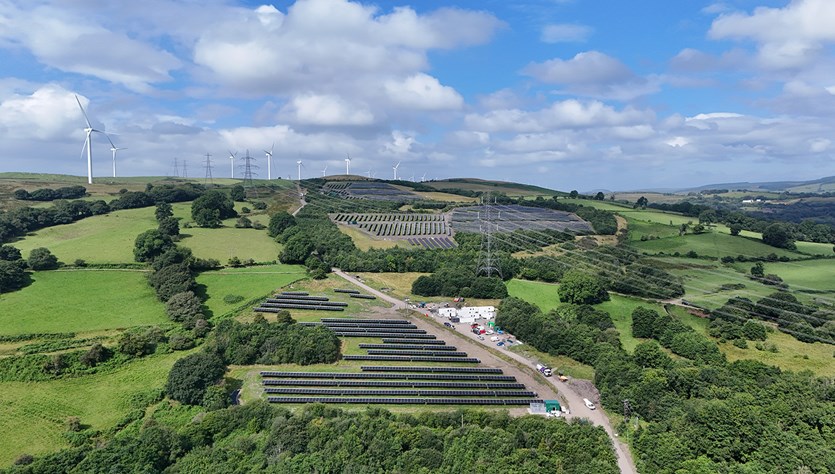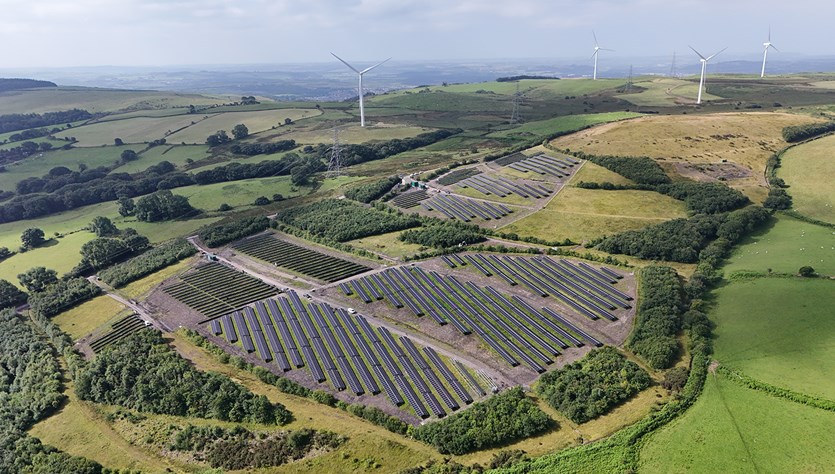The Coed Ely Solar Farm is a landmark project which has seen Rhondda Cynon Taf County Borough Council create a 6MW solar farm, but in an innovative collaboration, 1MW of the clean electricity generated will be exported to Royal Glamorgan hospital. Shortly after the project was finished we caught up with Rhondda Cynon Taf County Borough Council’s Coed-ely Solar Project Team to discuss the project...
What did this project mean to the council?
This project represented a bold step forward for the council, moving beyond our traditional delivery models to embrace a more innovative, partnership-led approach. By working closely with external stakeholders, we’ve not only delivered a major renewable energy installation, but also laid the groundwork for long-term financial sustainability through income generation. It’s a tangible example of how local authorities can lead on climate action while creating value for the public sector. The successful completion of the project, on time and in line with our strategic aims, reflects the strength of collaboration and the council’s commitment to delivering impactful, future-focused infrastructure.
How important was the preconstruction period and what should you look to achieve?
The detailed design and pre-construction phase was absolutely vital to the success of the project. It provided the opportunity to discharge planning conditions, secure essential consents, and develop the design to a level of maturity that gave everyone confidence moving forward. This period wasn’t just about ticking boxes, it was about building trust, aligning expectations, and ensuring that the technical and logistical groundwork was solid. It allowed us to engage meaningfully with stakeholders, clarify roles and responsibilities, and identify potential risks early on. Importantly, it also enabled the contractor to begin procurement with certainty, which helped maintain momentum and avoid delays later in the programme. That early investment in planning and coordination laid the foundation for a smooth delivery phase and ultimately contributed to the project being completed on time and to a high standard.
Do you feel like Vital Energi are a part of your wider team?
Initially, the team had some reservations about working with a contractor whose head office is based in the North West, quite a distance from our site in Wales. But those concerns were quickly put to rest. Vital Energi have consistently demonstrated that geography is no barrier to collaboration. From the outset, they’ve been fully engaged, always available, whether on site or at the end of the phone, and ready to support with any query or challenge. Their communication has been clear and proactive, and they’ve shown a genuine commitment to being part of the wider delivery team. It’s never felt like ‘us and them’, we’ve operated as one team with a shared goal. They’ve contributed not just technical expertise, but also a positive, solutions-focused attitude that’s helped us navigate complex aspects of the project. Their willingness to adapt, listen, and work collaboratively has made a real difference, and it’s been a pleasure having them as a key delivery partner.

The project delivery team used the pre-construction period wisely to plan for success.
What lessons have you learned during the delivery process which could help others?
One of the key lessons we’ve learned is the importance of prioritising legal documentation early in the process. These agreements can take significantly longer than expected to finalise, and having the right legal and commercial support in place from the outset is essential to avoid delays. It’s not just about drafting contracts—it’s about aligning stakeholders, clarifying responsibilities, and ensuring the project has a solid foundation to move forward.
Another critical insight is the value of strong relationships with local authorities, particularly around traffic management. Their input and influence can shape the feasibility and timing of works, especially when operating in sensitive or high-traffic areas. Engaging early and maintaining open communication with highways teams can make a real difference.
We also learned the importance of thorough ground investigation, especially when working on reclaimed or previously developed land. Understanding the site conditions in detail helped us minimise surprises during construction and allowed the design to be adapted accordingly. Investing in this early stage of work can save time, cost, and complexity later on.
Overall, these lessons highlight the need for proactive planning, strong stakeholder engagement, and a willingness to adapt as new information emerges. Sharing these insights can help other teams navigate similar challenges more effectively.
Part of this project is a power purchase agreement with a local hospital. How have Vital been at working in a live hospital environment?
One of the more challenging aspects of this project was coordinating civil and electrical works within the operational constraints of a live hospital setting. The hospital was already undergoing its own expansion works, and parking availability was a sensitive issue. Our project introduced further restrictions, which required careful negotiation and planning to avoid compounding disruption.
Vital demonstrated a strong understanding of the complexities involved in working within such a critical environment. From the outset, they engaged proactively in a series of detailed planning meetings with both our team and hospital stakeholders. These sessions focused on minimising disruption to hospital operations, particularly around access, safety, and parking logistics.
During the civil works phase, Vital worked collaboratively to develop phased approaches that allowed disruption to essential hospital functions to be minimised.
In the electrical works phase, Vital maintained a high level of professionalism and coordination. They ensured that all activities were scheduled around hospital peak times and critical services, with clear communication channels in place to respond to any issues swiftly. Their team was respectful of the environment, adhering to strict health and safety protocols and maintaining a low-impact presence on site.
How were we at resolving issues?
Throughout the project, our team demonstrated a proactive and solutions-focused approach to resolving issues as they arose. Working in a live hospital environment presented unique challenges, from access restrictions and parking limitations to coordinating around ongoing hospital operations, but they remained committed to maintaining progress while minimising disruption.
The team prioritised open communication and early engagement with stakeholders, which helped us identify potential issues before they escalated. Regular coordination meetings allowed us to respond quickly and collaboratively, ensuring that any concerns were addressed with clarity and care.
This responsiveness not only helped maintain momentum but also strengthened relationships with our partners and stakeholders, reinforcing trust and confidence in our approach.

The solar farm exports 1MW of electricity to the nearby Royal Glamorgan Hospital via a 3.2km private wire network.
What’s been the most positive part of the process?
The most rewarding part of this project has been working as part of a wider, multidisciplinary team all aligned around a shared goal. From the early planning stages through to delivery, there was a strong sense of collaboration and mutual respect across all parties involved, whether it was our internal teams, Vital, the hospital stakeholders, or external consultants.
Everyone brought their expertise to the table, and there was a genuine commitment to problem-solving, innovation, and delivering impact. That unity made even the more challenging aspects of the project feel manageable and purposeful. It created an environment where ideas could be shared openly, issues were tackled collectively, and successes were celebrated together.
This spirit of collaboration not only helped us deliver a technically complex project in a sensitive environment but also reinforced the value of partnership in achieving sustainable, long-term outcomes.
If you had one piece of advice for working with an energy partner, what would it be?
If the team had to give one piece of advice for working with an energy partner, it would be: invest time early in building a shared understanding of goals, constraints, and communication expectations.
Energy projects, especially those involving live environments like hospitals, are complex and often involve multiple stakeholders with competing priorities. Establishing a strong foundation of trust and transparency from the outset helps ensure that everyone is aligned and working toward the same outcomes.
Ultimately, the success of the partnership came down to clear communication, mutual respect, and a shared commitment to delivering impact with minimal disruption.